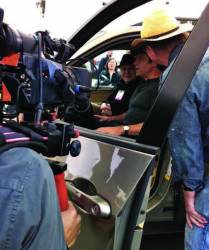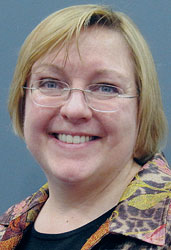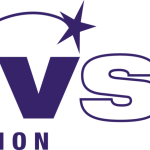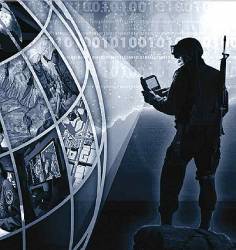 Mike Rowe, host of the Discovery Channel series Dirty Jobs, gets behind the wheel with MVSC’s HUD system at the Makers Faire in San Mateo, California. MVSC CEO Chris Grabowski sits in the passenger seat; CTO Tom Zamojdo is in straw hat. Photo by Valerie Hall.
Mike Rowe, host of the Discovery Channel series Dirty Jobs, gets behind the wheel with MVSC’s HUD system at the Makers Faire in San Mateo, California. MVSC CEO Chris Grabowski sits in the passenger seat; CTO Tom Zamojdo is in straw hat. Photo by Valerie Hall.A San Francisco Bay Area company — Making Virtual Solid–California (MVSC), which snared a trio of awards in a global GNSS competition for its novel approach to driver assistance, is still in early phases of development.
The origins of the company, however, go back more than 40 years to the Cold War era when its principals, Chris Grabowski and Tom Zamojdo, were studying physics and theoretical mathematics at the University of Warsaw, Poland.
But more about that later — first, the news.
A San Francisco Bay Area company — Making Virtual Solid–California (MVSC), which snared a trio of awards in a global GNSS competition for its novel approach to driver assistance, is still in early phases of development.
The origins of the company, however, go back more than 40 years to the Cold War era when its principals, Chris Grabowski and Tom Zamojdo, were studying physics and theoretical mathematics at the University of Warsaw, Poland.
But more about that later — first, the news.
In October, MVSC was declared overall winner of the European Satellite Navigation Competition (ESNC), which despite its name and the victor’s title, Galileo Master, is an eight-year-old worldwide contest that drew 100s of entries from nearly 50 countries. MVSC also gained a special topic prize for mobile enterprise solutions, sponsored by NAVTEQ, the well-known digital map company.
Among the rewards for their ESNC accomplishments is a €20,000 (US$27,800) cash prize. The NAVTEQ win brings benefits valued at approximately €75,000 ($101,250), including a 12-month incubation program that includes one year of free access to NAVTEQ map data, content, and services.
To be considered for the Galileo Master and special topic prizes, individuals and teams must first enter their application concepts in regional contests — which numbered 23 this year. These include the USA Challenge, the North American regional partnership organized by Inside GNSS magazine and cosponsored by NovAtel, Inc., and the Institute of Navigation.
MVSC captured the USA Challenge title in a close finish among 19 regional competitors with its novel head up display (HUD) for vehicle navigation, the True3D Volumetric HUD. In the first year of the North American contest, MVSC had finished within a few points of eVotz, the 2010 winner, on the strength of its Virtual Cable concept, an integral part of the HUD design.
(For further details on the North American regional competition, see the sidebar, “USA Challenge 2011,”)
True3D Volumetric HUD stood out in the regional and global competitions by falling under a safety-of-life category, which comprised only 13 percent of the ESNC entries. The majority of concepts (56 percent) entered are classified as “mass market” and the remainder, “professional” applications.
The USA Challenge winner also stood out because its inventors have working prototypes that they have been demonstrating over the past year. In contrast, many of the ESNC entries are essentially “bright ideas” that lack the engineering investment to, well, make the virtual into something solid.
Since April 2011, the company has entered an accelerated period of exposure to partners, press, public, and academic experts, says the company’s COO Juliana Carnes Clegg. They have the prototype and partners together at conferences and corporate headquarters throughout the United States and Europe. In May the prototype demo created a solid buzz at the Augmented Reality Event 2011 in Santa Clara, California, and the Maker Faire in San Mateo.
So, what is this innovation that has garnered so much attention?
True3D Volumetric HUD is an advanced, conformal system built into a vehicle or other platform that places accurately positioned images into a driver or pilot’s view of the real, physical world. Typically, the route ahead of the driver is indicated by a Virtual Cable running overhead in the driver’s viewscape.
Based on designs with patents pending in the United States, Japan, and the European Union, the company will offer a hardware-plus-interface (software) system incorporating inexpensive optics, low-cost lasers and robust mechanical parts, interacting with software that generates graphics to create conformal 3D in a miniature package, mountable in-dash or overhead as an after-market product for trucks.
Unlike other vehicle HUD designs, including a research prototype introduced by General Motors last year, the MVSC system requires no complex eye- or head-tracking elements, special gear for the driver, nor does it need to use abstract symbols such as arrows, numbers, or graphs to indicate distances (to a turn, for example).
(More of the technical details can be found in the sidebar, “A Technology Whose Time Had Already Come,”)
MVSC is targeting their HUD for use in markets where extreme accuracy in navigation and target identification saves lives: automobiles, trucks, homeland security, defense, and avionics. The company believes that medical device and gaming platforms also show strong potential, but current designs are focused on maximizing situational awareness for private drivers, truckers, security personnel, first responders, and similar groups.
Behind the Inventions
Grabowski is MVSC’s CEO, chief science officer, and the principal inventor and designer of the Virtual Cable and True3D Volumetric HUD technology. The concept drew on his broad knowledge of several seemingly disconnected areas of human/machine interface (HMI) design, optics, and the physiology of human vision.
Zamojdo is the chief technology officer and co-inventor of the MVSC core products. Developing the concepts into mature designs required cross-discipline knowledge of advanced optical design, including laser optics, electrical and mechanical engineering, and software engineering.
But neither man’s CV seemed to point toward such navigation-oriented, hardware-intensive systems in the automotive, aviation, and defense field.
For 18 years Grabowski was a software engineer at The Clearing House in New York, responsible for a complex real-time multilateral netting and settlement system that transfers more than $1 trillion a day among financial institutions worldwide.
Zamojdo worked for 10 years at Bell Labs and Bell Communications Research and then left to start a software engineering consulting company in North Carolina. That company provided custom software solutions to such clients as Wachovia, Bank of America and Duke Energy.
To find the origins of their MVSC collaboration, one needs to go back to 1979 when Grabowski and Zamojdo shared common courses at Warsaw University. At the time, Poland was a key member of the Soviet bloc, literally the namesake for the Warsaw Pact military alliance.
Had the two men continued in their academic fields — physics, math, and computer science — their professional trajectory might well have taken them into their nation’s missile program or similar military-related endeavors. Instead, they defected to the West, eventually settling in the New York area and becoming U.S. citizens.
From there they turned their skills toward software engineering — Grabowski writing software to secure financial institutions from use by criminal and terrorist organizations, Zamojdo designing software solutions for Fortune 500 companies. After eight years in North Carolina, Zamojdo returned to New York in 2001 to work with his compatriot on the Virtual Cable project.
“They grew up together,” says Clegg, who joined the company in 2009. “Their friendship is older than some of the wireless companies who want to buy us.”
She characterizes Grabowski as “very much the deep-brained scientist. Chris is acerbic, cool, and reserved. Tom is totally the opposite — a big bear of a man, funny, deeply compassionate, and has a work ethic the likes of which I rarely see.” The two men work together in their San Francisco lab, and in the apartment above it.
She met Grabowski and Zamojdo when they were testing the waters in Palo Alto — demonstrating their technology to auto companies. “Their consultants at the time didn’t know how to deal with Silicon Valley, where much of our future support would come from,” says Clegg. “I offered to house them for a year-plus and set them up with office space if they wanted to test the West Coast waters . . . and they never went back.”
Clegg began her career buying software companies for a Taiwan-American venture capital group, then subsequently co-founded an IT consultancy where she specialized in sales to international software companies and European Internet service providers.
In addition to her self-described roles of “incubator, investor, friend, banker, and marketer,” she has raised most of MVSC’s capital, developed the company’s advisory board, and secured its legal team. “Presenting the founders with partners and funders who are patient enough to foster this safety-of-life technology has been my main goal,” Clegg says.
The Business Opportunity
MVSC is a navigational systems development company, focused on developing intellectual property in the target markets (automotive, defense, trucking, avionics, marine) where its 3D HUD platform will have maximum benefit for life safety, situational awareness, and fuel efficiency. Based on its unique patents-pending designs, the company will offer a hardware-plus-interface (software) system.
To the company directors, the most accessible market is automotive, where car manufacturers are under pressure to find solutions in two areas: developing profitable advanced cabin technology and managing driver distraction.
Virtual Cable was developed first as a navigation tool and designed to provide comfortable, non-distracting guidance. It was developed long before the company’s principals or even automakers recognized that distraction would become the issue for drivers, legislators, and makers of in-cabin infotainment systems.
Even before car manufacturers got religion about non-distraction, however, they needed to find new technology-based features to improve their margins. Until now, those two mandates have been at odds — “cool tech” conflicting with the new focus on non-distraction.
MVSC’s business model calls for licensing and joint development with auto manufacturers, Tier 1 suppliers, defense contractors, and other large-scale players to maximize the value of the company’s core designs. Grabowski and Zamojdo expect to work collaboratively with several licensees, building out the firm’s in-house capacity to develop new intellectual property. However, the founders do not anticipate creating a large organization.
The company is already selling research product; so, it has both investment and revenue. “Profitability could come as soon as 2014,” says Clegg, “depending on how soon we enter the commercial trucking, fleet management and other sec¬tors. Automotive will be a longer haul to revenue.”
In early 2011 MVSC rebuilt the HUD in response to demand from the automotive industry. The new interface demonstrates the icons and symbols that auto company infotainment teams demanded. “We did it the old fashioned way,” says Clegg. “We bootstrapped to re-engineer on the fly so our future partners could really get a look at the broader capabilities of the system.”
With both interfaces available now, (Virtual Cable for navigational comfort, and Virtual Signs to demonstrate infotainment capabilities), the company is in a position to capitalize on being a global provider of these HUD interfaces for multiple markets — automotive, commercial fleet management, avionics and marine.
“At this point, Tom and Chris are probably more deeply educated about navigational HMI than most car companies,” says Clegg. “It would be difficult for anyone to mature these systems for cars or trucks without close collaboration with the inventors. But we’re looking forward to that. Our dialog with several car companies is excellent, very intimate at this point.”
Forget the Science — Leave the Driving to Us
As interesting as their technology may appear to an engineer, MVSC believes that it should be transparent to the driver, who is nonetheless able to use it with ease and comfort. The ultimate purpose of all this technology is to enable a simple, elegant, minimalist, yet extremely powerful visual route guidance.
But what is the ultimate purpose of this minimalist simplicity in MVSC’s human/machine interface? To create comfort, safety, and user-friendliness that leads to frequent usage — navigation as a part of a daily routine.
Over the last few years, many innovative people have produced ingenious solutions for a wide range of location-based services (LBS). Real-time weather infomation, crowd-sourced traffic, location-based advertising, searches, and so on.
In the United States, the vast majority of trips (83 percent) are made not on foot but by a private car, according to the Federal Highway Administration’s 2009 National Household Travel Survey. Yet countless efforts to influence a consumer at point A to become a customer at an unfamiliar point B have not been paying off.
Why the disconnect? Grabowski, Zamojdo, and others at their company believe they know the reason: The currently stressful and unsafe nature of navigating unknown neighborhoods keeps large numbers of potential clients away. Solving this problem will allow small retail businesses to attract customers from the outside of their local area, unlocking currently untapped revenues from advertising and other LBS services.
Based on their extensive experience with hundreds of people driving their test car, the company believes that navigating an unfamiliar route using the Virtual Cable is just as convenient to the driver as navigating a familiar route where no navigational aid is needed.





